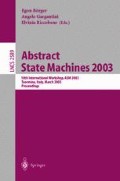Abstract
The question raised in [15] is answered how to naturally model widely used forms of recursion by abstract machines. We show that turbo ASMs as defined in [7] allow one to faithfully reflect the common intuitive single-agent understanding of recursion. The argument is illustrated by turbo ASMs for Mergesort and Quicksort. Using turbo ASMs for returning function values allows one to seamlessly integrate functional description and programming techniques into the high-level ‘abstract programming’ by state transforming ASM rules.
Access this chapter
Tax calculation will be finalised at checkout
Purchases are for personal use only
Preview
Unable to display preview. Download preview PDF.
References
M. Anlau.. XASM-an extensible, component-based abstract state machines language. In Y. Gurevich, P. Kutter, M. Odersky, and L. Thiele, editors, Abstract State Machines: Theory and Applications, volume 1912 of LNCS, pages 69–90. Springer-Verlag, 2000. 220
A. Blass and Y. Gurevich. Abstract State Machines capture parallel algorithms. ACM Transactions on Computational Logic, 3, 2002. 220
A. Blass and Y. Gurevich. Algorithms vs. machines. Bulletin EATCS, 2002. 218, 219, 226, 227
E. Börger. High level system design and analysis using abstract state machines. In D. Hutter, W. Stephan, P. Traverso, and M. Ullmann, editors, Current Trends in Applied Formal Methods (FM-Trends 98), number 1641 in LNCS, pages 1–43. Springer-Verlag, 1999. 225
E. Börger. Computation and specification models. A comparative study. In P. Mosses, editor, Proc. FLoC’02 Workshop Action Semantics and Related Semantic Frameworks, BRICS Series. Department of Computer Science at University of Aarhus, 2002. 227
E. Börger. The origins and the development of the ASM method for high level system design and analysis. J. of Universal Computer Science, 8(1):2–74, 2002. 222, 226
E. Börger and J. Schmid. Composition and submachine concepts for sequential ASMs. In P. Clote and H. Schwichtenberg, editors, Computer Science Logic (Proceedings of CSL 2000), volume 1862 of LNCS, pages 41–60. Springer-Verlag, 2000. 218, 220, 221, 222
E. Börger and R. Stärk. Abstract State Machines. A Method for High-Level System Design and Analysis. Springer-Verlag, 2003. 222, 225
Foundations of Software Engineering Group, Microsoft Research. AsmL. Web pages at http://research,kmicrosoft.com/foundations/AsmL/, 2001. 220
N.G. Fruja and R. F. Stärk. The hidden computation steps of turbo Abstract State Machines. In E. Börger, A. Gargantini, and E. Riccobene, editors, Abstract State Machines 2003. Springer, 2003. 222
Y. Gurevich. Evolving Algebras 1993: Lipari Guide. In E. Börger, editor, Specifi-cation and Validation Methods, pages 9–36. Oxford University Press, 1995. 219
Y. Gurevich. Sequential Abstract State Machines capture sequential algorithms. ACM Transactions on Computational Logic, 1(1):77–111, July 2000. 220
Y. Gurevich and M. Spielmann. Recursive Abstract State Machines. J. of Universal Computer Science, 3(4):233–246, 1997. 218, 219, 226
P. Kutter. The formal definition of Anlauff’s eXtensible Abstract State Machine. TIK-Report 136, ETH Zürich, June 2002. 221
Y. N. Moschovakis. What is an algorithm? In B. Engquist and W. Schmid, editors, Mathematics Unlimited-2001 and beyond. Springer, 2001. 218, 219, 226
J. Schmid. Executing ASM specifications with AsmGofer. Web pages at http://www.tydo.de/AsmGofer. 220
Author information
Authors and Affiliations
Editor information
Editors and Affiliations
Rights and permissions
Copyright information
© 2003 Springer-Verlag Berlin Heidelberg
About this paper
Cite this paper
Börger, E., Bolognesi, T. (2003). Remarks on Turbo ASMs for Functional Equations and Recursion Schemes. In: Börger, E., Gargantini, A., Riccobene, E. (eds) Abstract State Machines 2003. ASM 2003. Lecture Notes in Computer Science, vol 2589. Springer, Berlin, Heidelberg. https://doi.org/10.1007/3-540-36498-6_12
Download citation
DOI: https://doi.org/10.1007/3-540-36498-6_12
Published:
Publisher Name: Springer, Berlin, Heidelberg
Print ISBN: 978-3-540-00624-4
Online ISBN: 978-3-540-36498-6
eBook Packages: Springer Book Archive

